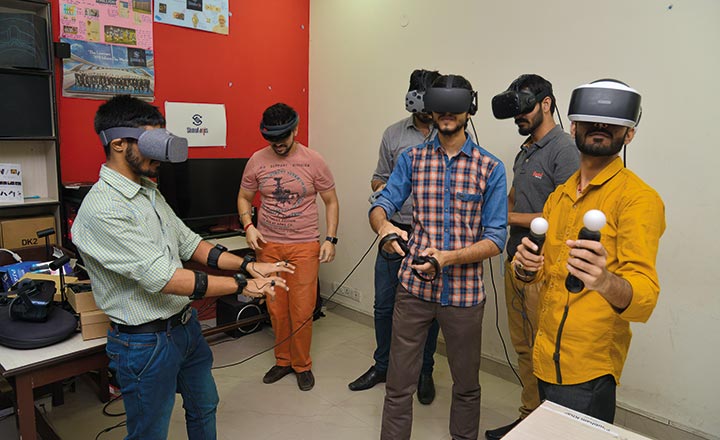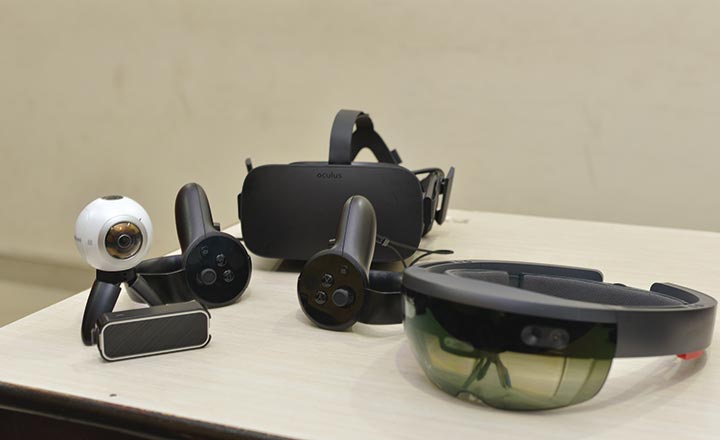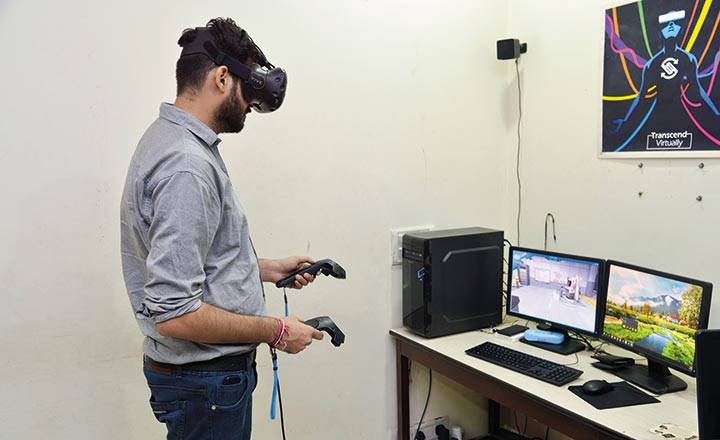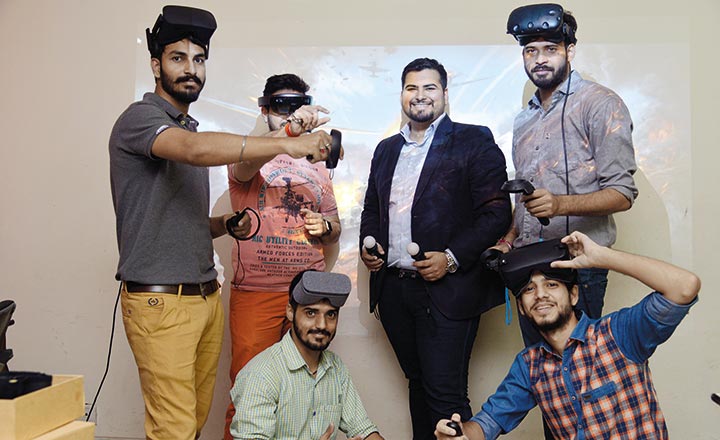The scene is a virtual construction site. By clicking the ‘play’ button that appears on your mobile or computer screen you enter the site. You walk towards an office located amid half constructed buildings, trucks, cement sacks and cranes. The site officer gives you your first task — operate a crawler crane.
A few consignments that arrived today have to be carried to a particular spot within the stipulated time, safely. Once inside the crane, you conduct all safety checks and start operating it. The consignments are found from different parts of the site and carried to the assigned spot. The task is completed successfully and you receive points as reward. This might sound like a game, but the scene is from a virtual reality (VR) and gamification-based training session that Simulanis — a Delhi based start-up — has developed. As the name suggests the company develops augmented reality (AR), VR and gamification-based real-life simulations to impart effective training to workforce and engineering students. Simulanis’ VR for crane operation is one among many such simulations and it took founder and CEO Raman Talwar, couple of pivots and course corrections to land upon the idea.
Talwar, a 28-year-old chemical engineer, worked for a couple of years in England’s pharmaceutical industry, after graduation. In 2012, he came to India with the idea of working in his father’s engineering business. It didn’t take long for him to realise that he possessed the skill sets to do much more.
So in 2013, he started the company to provide consultancy services in engineering. It was indeed a revenue generating business, but a few recruiting experiences gave Talwar another new business idea. Many of his recruits didn’t have the required skills and later, they had to be trained internally. Apart from knowing basic programming languages, the recruits are expected to work on standard computer-based office packages, develop, developing simple calculation tools using programming techniques and aid routine engineering design work, typically performed by engineering design consultancies and manufacturing companies
Talwar identified that this in itself was a pretty big opportunity and decided to steer the wheel in that direction. He took to training people in his own facility and also visited colleges and universities to train engineering students.
Around mid-2014 he decided to take the training online as that seemed to offer much more scale. Talwar was convinced that a gamified approach along with simulation was the best way to provide the trainees with a hands-on experience of the job. By 2015, the company added an AR/VR layer to its content-centric training products. The start-up made it to the first batch of India’s first EdTech accelerator, Edugild towards the end of 2015. Today, its offerings include Saral, an AR learning platform, and Protocol, a gamified learning platform.
Virtual games
Although the AR/VR market in India is at its nascent stages now, Talwar believes it is set to grow. But for now, gamification remains the core offering of Simulanis.
Requiring only a mobile or computer, the team believes that gamification is more user-friendly than AR/VR; it doesn’t demand an incremental behaviour change. AR/VR requires using peripherals such as head mounted displays, wearables etc. Talwar is quite optimistic though. They are working on wearables, and have a few partnerships with foreign companies. The products are compatible with different types of hardware that allows the team to deploy the complete package quickly.

“We do not distinguish between the content provided through our gamification and AR/VR offering,” says Talwar. “It’s like Slack or LinkedIn or Facebook — you can consume it on desktop or mobile application. Similarly, we are trying to give a gamified, AR and VR output for the same content through an integrated approach of developing all these things,” he adds. The approach intertwines the AR/VR outputs through a ‘toggle’ mode — one of the USPs of the products and applications developed by the start-up. This gives users the ability to switch between AR and VR modes, thereby completing the immersive and interactive learning experience.
Simulanis is quite clear about its target sectors. With enough animation videos already floating on the internet for K-12 education, the team is convinced that adding more content there — even if its AR/VR — is pointless.
The idea is to try and solve problems hence, they decided to address the gap in the market — improving the skill levels of engineering students and the industrial workforce segment. According to the National Skills Development Corporation, India will require 119 million more skilled workers by 2022 across 24 sectors in the economy

Research suggests that the human brain remembers around 90% of what it does. The figure shrinks to 20% when one listens and 10% when one reads.The conventional engineering education system provides very few opportunities for hands-on education. Relying heavily on reading and listening leaves a large section of graduates unemployable. If recruited, they need to be trained internally spending a lot of money and resources. Even then, traditional ways of training are not deemed very effective. This is where Simulanis steps in to make a change.
Its strong technical team ensures that a lot of visualisation goes into the content to make it a deeply engaging experience unlike most upskilling content available online. Simulanis hand holds the trainee or student through the entire life cycle of training. “We want to make sure that completion rates are as high as possible,” says Talwar. The content is delivered in the form of online modules over the cloud, or as standalones offline. This is managed by the start-up’s own online software licence management dashboard.
The company which started with an initial investment of Rs.15 lakh has been generating revenue since day one, according to Talwar. It has clocked a revenue of Rs.1.9 crore since 2013 and saw a turnout of Rs.62 lakh in FY16-17. With around 50 clients so far such as GSK, Johnson & Johnson, JITF Aquasource, Ramp Technology, Fluor and Jacobs, Simulanis has trained over 2,000 people till date. This includes a diverse mix of students from various colleges, universities and employees from sectors such as pharma, automotive and FMCG.
“We have been associated with Simulanis since 2014 for training our staff through VR. We manage to train them without exposing them to the hazardous chemicals. The training experience is very effective and helps us save several man-days. Compared to the traditional method, the staff enjoys this a lot more and remember what they were taught,” says Kanheya Mehrotra, head, Engineering Technology Centre, GSK.
Future proof
The start-up follows a licence subscription based model for the educational AR/VR content, while companies are charged based on different package suites selected by them.
Talwar aims to train 5,000 people by the end of this financial year. While the company started off training students, today 80% are employees. Talwar has his eyes set on more sectors such as defence, oil, gas and aerospace.
“We are not directly going to customers, we are still building a library of content. But eventually it will be sold as a SaaS-based subscription model,” he notes. Till date, Simulanis has been servicing its clients on a standalone basis depending on their needs and now is in the process of handing out licences to business partners. Talwar expects it to be streamlined within six months to one year. “Right now the pricing is very specific to each company, but licensing and subscription model is what we are aiming for,” he says.
The company has developed in-house software applications and it has also invested to come up with its own mobile hardware for VR. Talwar believes it would allow the team to scale faster at a cheaper cost within India, where it is crucial to make it very affordable for the masses.
With a vision of becoming a global company, Simulanis is looking to increase its presence in Europe, America, and South-East Asia. While most of its customers have been from the Delhi-NCR region, the startup is already working with a few clients in Europe.
It has a product development and R&D office in Manchester and aims to expand its overseas operations. It’s also currently in talks with a few players in the US so as to cover Atlanta, California and the Bay area.

Simulanis raised its seed investment at Edugild and after graduating raised another round of funding from the Edugild portfolio of VCs. The start-up later applied for to a hyper-accelerator, run by US-based Village Capital. Simulanis ended up winning and attracted a pre-series A investment from a clutch of investors.
Apurva Chamaria, angel investor at Simulanis and VP and head – corporate marketing, HCL Technologies, has made it a practice to observe a company atleast for a couple of years before investing in it. He has been seeing the growth of Simulanis over the past two years and was impressed with quite a few things. “One, they are part of a big fast growing market. AR/VR in India will grow into a Rs.6,700 crore market by 2018. Globally the market is going to be $37 billion-$38 billion, from $11.4 billion presently,” says Chamaria. This was topped up with a sharp focus on a couple of verticals. “The opportunity in pharma is huge. What’s more, tomorrow the use cases are extendable to other machine-dependant industries such as defence, oil and gas. They are only scratching the surface right now. Year-on-year they are doubling their revenue and there has been zero attrition in the past three years. That speaks volumes about the entrepreneur,” notes Chamaria. According to him companies are increasingly moving away these days from the age-old training methods with availability of training online as well as data suggesting the ineffectiveness of the traditional methods. Around 60-70% of training is forgotten in the first week and 90% in two weeks. “When you think about machine-critical industries, this is scary because accidents can happen. In case of Simulanis, here you are not just seeing a video but using the actual machines through simulations. Learning retention is far, far higher here,” Chamaria points out.
A team of 30 now, Simulanis plans to hire more people to strengthen it and expand its operations, to achieve its target of Rs.1.2 crore for the next financial year. The start-up aims to rope in around 20-30 clients over the next year and also open the service to B2C customers in the long run. Talwar explains his scale up plan, “We want to see ourselves as a company which builds simulators be it on AR, VR, gamification or any new technology as we go forward. Over the next year we hope to have a team of 50 people and start operations in five to six industries — we are in three now. We hope to open an education vertical, do more targeted work and sell globally.” The start-up is currently entering technology partnerships with US-based companies such as NVIDIA and hopes to partner with many more in the coming future. Talwar admits market adaptation is a challenge and therefore is working to build awareness. “We need to make sure we are at the right place at the right time,” he says.











 Just one email a week
Just one email a week